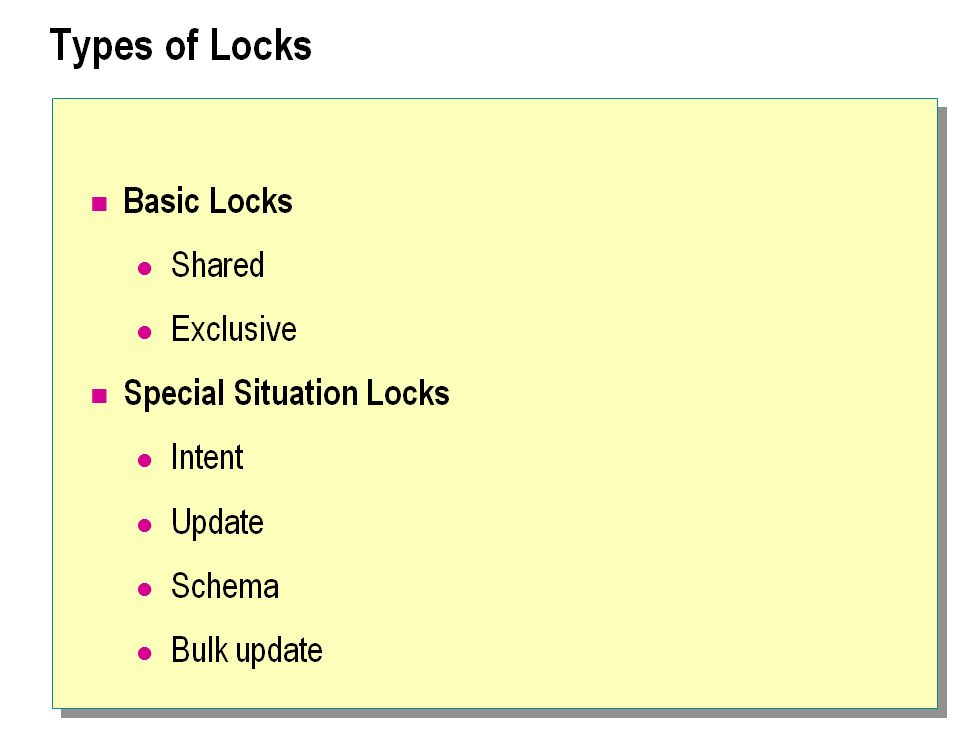Types Of Locks In Sql Server The first represents the type of lock used to lock the index range RangeT and the second represents the lock type used to lock a specific key K The two parts are connected with a hyphen such as RangeT K The SQL Server lock counters in the Windows Performance Monitor will display information about memory used by partitioned and
Solution Locking is integral to the successful processing of transactions in any relational database management system RDBMS worth its reputation It is important in SQL Server that transactions pass the ACID test Durable the RDBMS will maintain a record of uncompleted transactions in the event of recovery during a failure Acquire locks in a consistent order Deadlocks can often be avoided by acquiring locks in a consistent order across all transactions This reduces the chances of circular dependencies between transactions Use appropriate lock types Use shared locks for read operations and exclusive locks for write operations Avoid using higher level locks
Types Of Locks In Sql Server

Types Of Locks In Sql Server
https://3.bp.blogspot.com/-ZQxm6FIVBPg/UMbQ2_SLbnI/AAAAAAAAFPk/X6Gh1p2ZGBk/s1600/Types+of+Locks+in+SQL+Server.jpg

SQL Server 2022 Paid Editions Require A Licensing Key Brent Ozar
https://www.brentozar.com/wp-content/uploads/2022/11/sql_server_2022_licensing_key.png

Locks In SQL Server YouTube
https://i.ytimg.com/vi/NX5yCF5Myvs/maxresdefault.jpg
The SQL server MSDN page has a reasonable explanation An intent lock indicates that SQL Server wants to acquire a shared S lock or exclusive X lock on some of the resources lower down in the hierarchy For example a shared intent lock placed at the table level means that a transaction intends on placing shared S locks on pages or rows GO Step 2 Set up a trace to capture the blocked process report Run it as a server side trace It should contain one event Errors and Warnings Blocked Process Report It needs just two columns Text spid This sample server side trace will run for five minutes and automatically stop You must change the path to a valid directory SQL
Applies to SQL Server The SQLServer Locks object in Microsoft SQL Server provides information about SQL Server locks on individual resource types Locks are held on SQL Server resources such as rows read or modified during a transaction to prevent concurrent use of resources by different transactions For example if an exclusive X lock A lock as an in memory structure is 96 bytes in size so locking millions of rows could have a high overhead compared to gaining a singular lock on the table SQL Server uses lock escalation to manage the locking granularity Lock escalation is internally managed and decides at which point to move a set of locks to a higher granularity
More picture related to Types Of Locks In Sql Server

Lock A SQL Table Manually Forcefully Guruji Point Code You Want
https://3.bp.blogspot.com/-J_Ic5QpITxw/WXeKOtn9FjI/AAAAAAAABWA/YxQKB_bb_u4Cu93cJyj3jcuxdD13VCuBgCLcBGAs/s1600/gurujipoint_lock.jpg

Locks In SQL Server To Manage And Control Transaction Concurrency
https://codingsight.com/wp-content/uploads/2021/08/Manage_Transaction_Concurrency_using_locks_878х700_3.png

SQL Server CRUD Operation Examples
https://www.mssqltips.com/tipimages2/7369_crud-operations-sql-server-examples.001.png
Update locks U Update locks are a mix of shared and exclusive locks When a DML statement is executed SQL Server has to find the data it wants to modify first so to avoid lock conversion deadlocks an update lock is used Only one update lock can be held on the data at one time similar to an exclusive lock To identify locks you can use the sp lock system stored procedure This procedure shows all the locks currently held in the system and the processes that are requesting them Here is a simple example EXEC sp lock This command will return a table that includes information like the process ID the type of lock the object the lock is on
SQL Server uses locks to control how multiple transactions interact with the same resources simultaneously Let s discuss the various types of locks in SQL Server Shared Locks Shared locks are used when a transaction wants to read a resource These locks are non exclusive meaning that multiple transactions can hold shared locks on the same A statement is issued by an application SQL Server compiles the statement and determines the types of locks that are needed to most efficiently satisfy the query Once all locks are acquired the transaction is in a ready state SQL Server will begin operations and release locks as appropriate

Troubleshooting Database Locks In SQL Server How To Find And Resolve
https://rkicdn.rkimball.com/how_to_find_database_locks_in_sql_server.png

How To Create ER Diagrams In SQL Server Creative Crafting
https://craftsnactivities.com/wp-content/uploads/2023/03/How-to-Create-ER-Diagrams-in-SQL-Server.jpg
Types Of Locks In Sql Server - A lock as an in memory structure is 96 bytes in size so locking millions of rows could have a high overhead compared to gaining a singular lock on the table SQL Server uses lock escalation to manage the locking granularity Lock escalation is internally managed and decides at which point to move a set of locks to a higher granularity